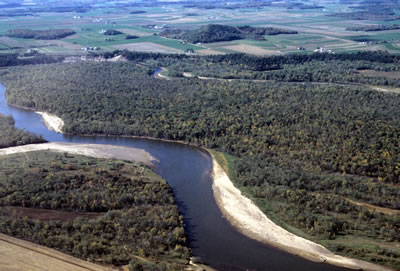Lower Chippewa River
Project Description

The conservation plan for this IBA was developed concurrently with a WDNR master plan for the state properties of the Lower Chippewa. A master plan is a set of documents that details the resource management, facility development, and public use that will take place on a state property or collection of properties—it is a property’s management “blueprint”. The master planning process for the Lower Chippewa properties provided an excellent opportunity to develop a complementary, bird-focused document for land managers that would strategically identify high-priority bird species and habitats and propose recommendations for their management and monitoring. The IBA conservation planning process also included consideration of Xcel Energy’s Tyrone Property, which was not treated in the master plan.
The IBA conservation plan was finished in February, 2010. It is entitled Managing for Priority Birds on the Lower Chippewa River Important Bird Area. This document will be a valuable guide to land managers within the IBA as they engage in ongoing management across this complex and ecologically rich landscape.
Next Steps
Inventory and monitoring were two needs identified repeatedly in the IBA report for the Lower Chippewa properties. There was a biotic inventory effort preceding the development of the master plan which included bird surveys and generated some recent data. However, these inventories targeted only certain areas of the public properties. The privately-owned Tyrone Property has almost no bird data at all. The general lack of comprehensive bird survey data across the whole IBA made the process of estimating populations of priority species a challenge, and complicates attempts to set population objectives or gauge effects of management.
A 2010 Citizen-based Monitoring grant to the Chippewa Savannas Chapter of The Prairie Enthusiasts (TPE) has begun filling this data gap for the priority grassland birds. TPE is using this grant to establish long-term citizen monitoring of grassland and savanna birds, targeting the two properties on the IBA with the highest potential to manage for priority grassland species—Dunnville Wildlife Area and the Tyrone Property. Data were collected at these properties during the 2010 breeding season. A final report will be made available to land managers.
An important inventory and monitoring gap remains for forest birds, particularly on the Tiffany Wildlife Area, the IBA’s largest property and major forest opportunity. The extensive forested landscape here makes forest birds such as cerulean warbler, Kentucky warbler, and prothonotary warbler an even higher priority on the IBA than grassland birds. Tiffany, with its extensive floodplain forests and adjacent upland forests on steep bluffs, presents a demanding monitoring environment. It is a large, remote property with difficult access. Establishing monitoring for priority forest birds at Tiffany and other key forested tracts along the Lower Chippewa will be this IBA’s next challenge.
